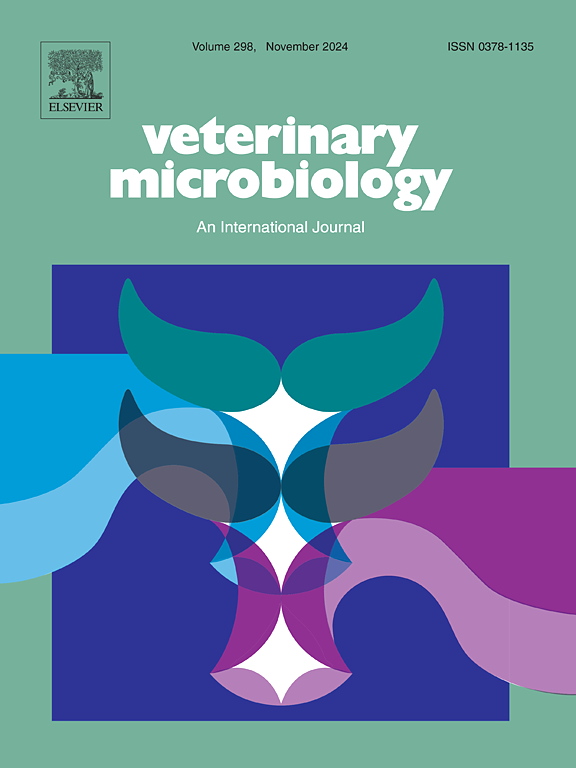禽致病性大肠杆菌噬菌体在家禽业生物膜生物防治中的应用。
IF 2.4
2区 农林科学
Q3 MICROBIOLOGY
引用次数: 0
摘要
禽致病性大肠杆菌(APEC)是禽大肠杆菌病的主要病原体,由于高死亡率和使用抗生素治疗疾病,对家禽业造成重大经济损失。APEC及其在食品和加工表面形成生物膜的能力有助于其在农场内的持久性。噬菌体是一种很有前途的抗APEC抗菌剂。本研究重点对新分离的噬菌体UPWr_E1、UPWr_E2和UPWr_E4以及包含这三种噬菌体的噬菌体鸡尾酒UPWr_E124进行了表征。方法包括电镀效率测定,透射电镜,以及对不同pH值和温度的抗性表征。此外,噬菌体基因组测序,注释和分析,并与先前测序的大肠杆菌噬菌体进行比较。这三种噬菌体都是有毒的,没有治疗所需的不良基因。噬菌体UPWr_E1属于straboviriae目的Krischvirus属,UPWr_E2和UPWr_E4属于Tevenvirinae亚科的Tequatrovirus属,它们之间的核苷酸同源性超过95% %。为了在家禽养殖场中使用,UPWr_E噬菌体和UPWr_E124噬菌体鸡尾酒在两个非生物表面(96孔微孔板,不锈钢表面和以生菜叶为代表的生物表面)上测试了它们对大肠杆菌菌株158B (APEC)和强生物膜生产者NCTC 17848的抗生物膜活性。两菌株在96孔微孔板上,在不锈钢和生菜叶片表面进行噬菌体处理,形成的生物膜的还原效率非常高,分别为50.2- 83.6%,58.2-88.4和53- 99.4% %。因此,我们得出结论,UPWr_E噬菌体和UPWr_E124噬菌体鸡尾酒是APEC生物防治的有希望的候选噬菌体。本文章由计算机程序翻译,如有差异,请以英文原文为准。
Avian pathogenic Escherichia coli-targeting phages for biofilm biocontrol in the poultry industry
Avian pathogenic Escherichia coli (APEC) is a principal etiologic agent of avian colibacillosis, responsible for significant economic losses in the poultry industry due to high mortality and disease treatment with antibiotics. APEC and its ability to form biofilms on food and processing surfaces contributes to its persistence within farms. Bacteriophages are promising antibacterial agents for combating APEC. This study focused on characterization of the newly isolated phages UPWr_E1, UPWr_E2, and UPWr_E4 as well as the UPWr_E124 phage cocktail containing these three phages. Methods included efficiency of plating assay, transmission electron microscopy, and characterization of their resistance to different pH values and temperatures. Moreover, phage genomes were sequenced, annotated and analyzed, and were compared with previously sequenced E. coli phages. All three phages are virulent and devoid of undesirable genes for therapy. Phage UPWr_E1 belongs to the genus Krischvirus within the order Straboviridae and both UPWr_E2 and UPWr_E4 belong to the genus Tequatrovirus within the subfamily Tevenvirinae, sharing over 95 % nucleotide identity between them. For their use on poultry farms, UPWr_E phages and the UPWr_E124 phage cocktail were tested for their anti-biofilm activity on two E. coli strains – 158B (APEC) and the strong biofilm producer NCTC 17848 – on two abiotic surfaces: a 96-well microplate, a stainless steel surface, and one biotic surface, represented by lettuce leaves. The reduction of biofilm formed by both strains in the 96-well microplate, on the stainless steel and lettuce leaf surface for bacteriophage treatment was very efficient, reducing biofilms by ranges of 50.2–83.6, 58.2–88.4 and 53–99.4 %, respectively. Therefore, we conclude that UPWr_E phages and the UPWr_E124 phage cocktail are promising candidates for APEC biocontrol.
求助全文
通过发布文献求助,成功后即可免费获取论文全文。
去求助
来源期刊

Veterinary microbiology
农林科学-兽医学
CiteScore
5.90
自引率
6.10%
发文量
221
审稿时长
52 days
期刊介绍:
Veterinary Microbiology is concerned with microbial (bacterial, fungal, viral) diseases of domesticated vertebrate animals (livestock, companion animals, fur-bearing animals, game, poultry, fish) that supply food, other useful products or companionship. In addition, Microbial diseases of wild animals living in captivity, or as members of the feral fauna will also be considered if the infections are of interest because of their interrelation with humans (zoonoses) and/or domestic animals. Studies of antimicrobial resistance are also included, provided that the results represent a substantial advance in knowledge. Authors are strongly encouraged to read - prior to submission - the Editorials (''Scope or cope'' and ''Scope or cope II'') published previously in the journal. The Editors reserve the right to suggest submission to another journal for those papers which they feel would be more appropriate for consideration by that journal.
Original research papers of high quality and novelty on aspects of control, host response, molecular biology, pathogenesis, prevention, and treatment of microbial diseases of animals are published. Papers dealing primarily with immunology, epidemiology, molecular biology and antiviral or microbial agents will only be considered if they demonstrate a clear impact on a disease. Papers focusing solely on diagnostic techniques (such as another PCR protocol or ELISA) will not be published - focus should be on a microorganism and not on a particular technique. Papers only reporting microbial sequences, transcriptomics data, or proteomics data will not be considered unless the results represent a substantial advance in knowledge.
Drug trial papers will be considered if they have general application or significance. Papers on the identification of microorganisms will also be considered, but detailed taxonomic studies do not fall within the scope of the journal. Case reports will not be published, unless they have general application or contain novel aspects. Papers of geographically limited interest, which repeat what had been established elsewhere will not be considered. The readership of the journal is global.
 求助内容:
求助内容: 应助结果提醒方式:
应助结果提醒方式:


